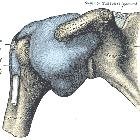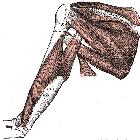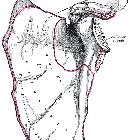Shoulder joint





Simply put, the shoulder, or shoulder joint, is the connection of the upper arm and the thorax. Comprising of numerous ligamentous and muscular structures, the only actual bony articulations are the glenohumeral joint and the acromioclavicular joint (ACJ). The shoulder allows for a large range of motion, but is also more prone to dislocation and other injuries.
Gross anatomy
Location
The glenoid fossa of the scapula articulates with the anatomical head of the humerus as a synovial ball and socket joint. The glenoid fossa is deepened by the glenoid labrum.
The joint capsule attaches proximal to the glenoid fossa and attaches further distally to the anatomical neck of the humerus. The capsule is looser inferiorly to allow for tightening during abduction.
Movements
- flexion: anterior fibers of deltoid, coracobrachialis, biceps brachii
- extension: posterior fibers of deltoid, teres minor, teres major
- abduction: supraspinatus, deltoid, trapezius
- adduction: pectoralis major, subscapularis, teres major, latissimus dorsi
- internal rotation: teres major, latissimus dorsi, pectoralis major
- external rotation: infraspinatus, teres minor
Bursae
Numerous bursae are associated with the shoulder joint, which include the subacromial-subdeltoid and subcoracoid bursae.
Ligaments
- superior, middle and inferior glenohumeral ligaments, from their attachments along the anterior surface of the glenoid fossa extending further inferiorly
- transverse humeral ligament (holds long head of biceps down as it runs in the intertubercular groove)
- coracohumeral ligament
- long head of biceps (from supraglenoid tubercle) is intracapsular, running in the superior portion of the joint
- long head of triceps at its origin (from infraglenoid tubercle) also supports the joint inferiorly
- also reinforced by important extrinsic ligaments including the acromioclavicular, coracoacromial and coracoclavicular ligaments
Tendons
The shoulder joint is reinforced by the rotator cuff muscles/tendons:
- supraspinatus: from supraspinous fossa to superior facet on greater tubercle
- infraspinatus: from infraspinous fossa to middle facet on greater tubercle
- teres minor: from inferolateral border of the scapula to the inferior facet on the greater tubercle
- subscapularis: from the subscapular fossa to the lesser tubercle
Arterial supply
Arterial supply is from the branches of the scapular anastomosis but primarily from the axillary artery:
Venous drainage
Veins with corresponding names, accompany the arteries, and drain the shoulder via a periscapular venous plexus.
Innervation
Siehe auch:
- Buford-Komplex
- sublabrales Foramen
- sublabraler Recessus
- Musculus teres minor
- Musculus infraspinatus
- Ligamentum coracoclaviculare
- Schultermuskulatur
- Musculus subscapularis
- Musculus supraspinatus
- Glenohumerale Bänder
- Articulatio acromioclavicularis
- labral variants
- Ursprung lange Bizepssehne
- Musculus biceps brachii, Caput longum
- kurze Bizepssehne
und weiter:

 Assoziationen und Differentialdiagnosen zu Schulter Anatomie:
Assoziationen und Differentialdiagnosen zu Schulter Anatomie:









